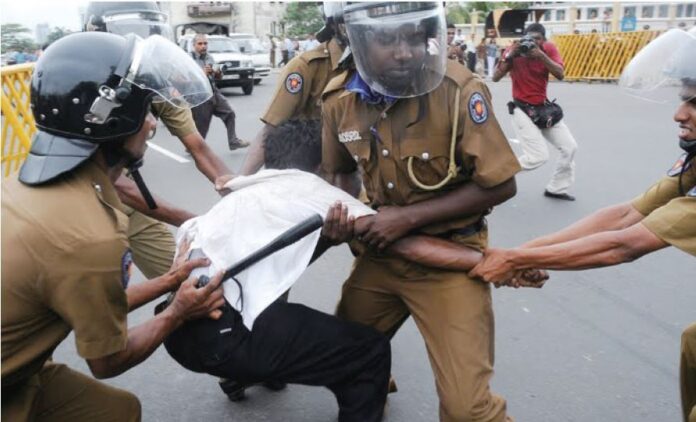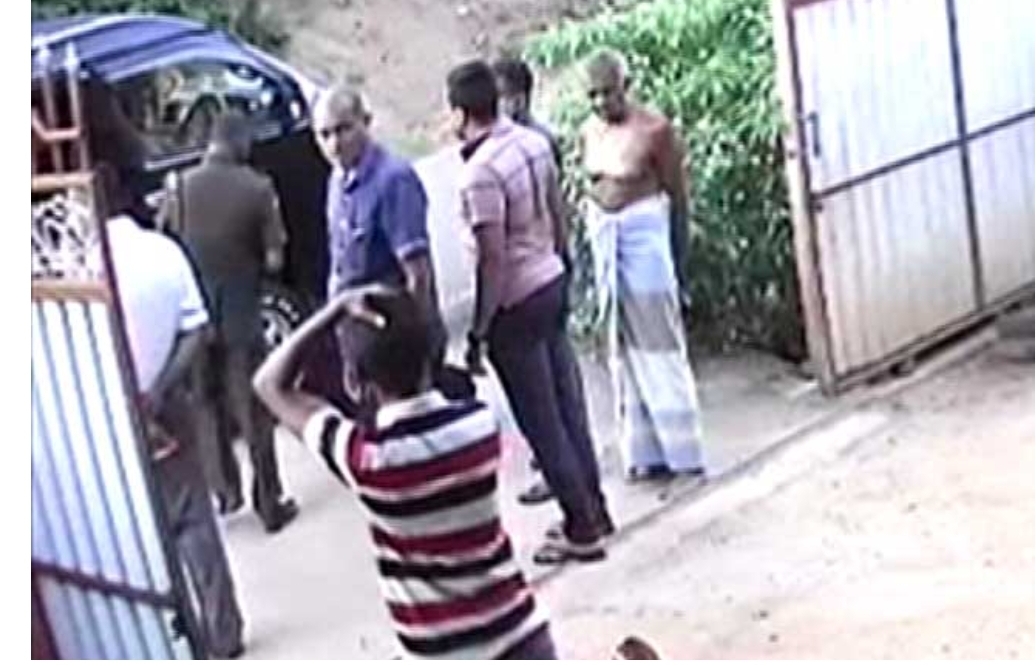‘So it seems to me that despite so many decisions, torture at police stations continues unabated, in utter contempt of fundamental rights guaranteed by the Constitution…’[1]-Justice Kulatunga
A 14-year old autistic boy assaulted by the police.[2] Peaceful protesters arrested using violence.[3]A teenager taken to the police station until his father arrives for questioning.[4] These are three instances of police brutality and arbitrary action in the past few weeks that led to public outrage. Other instances of police violence, such as the alleged torture of two men by Kayts police[5], the alleged assault of a man in his home by Vaddukkodai police[6], and the alleged assault of a differently-abled man in Keerimalai[7],went largely unnoticed and didn’t elicit public outrage because they were reported only in the Tamil media. Although police violence is a well-documented problem that spans decades and successive governments, it was apparent that those who expressed outrage viewed these incidents as aberrations.
Torture in Sri Lanka: an aberration?
The reactions of those who are part of the state to the aforementioned incidents have focused on the ‘image of the police’, which they’ve reiterated shouldn’t be tarnished as a result of what they describe as isolated incidents. For instance, the National Police Commission (NPC), the Constitutionally mandated police oversight body, stated that, “Just because of a few errant officers and a few incidents, we cannot say that the entire Police Force is heading in the wrong direction”.[8]The NPC, by touting the ‘few bad apples’ theory, is ignoring the systemic and structural nature of the problem.
Gerald Perera and Nandini Herat who were tortured by Wattala and Wariyapola police respectively in 2002, and the torture of K.A. Somaratne[9] in 2012 by Mundalama police, are just a few cases spanning a decade and different governments that point to the systemic nature of police violence. Deaths due to police violence during this period include the custodial deaths of Dinesh and Danushka in Angulana[10] and the death of a Balawarnam Sivakumar, a man with mental health problems in Colombo, both in 2009. Sivakumar was beaten by a group of policemen after he had pelted a passing train with stones.He was chased by the police into the ocean, and was beaten and prevented from coming ashore until he drowned. The incident was witnessed by a large group of people who were on the beach as well by a cameraman for a media organisation who recorded the incident.[11]
In all the aforementioned cases of torture the individuals suffered severe physical injuries, were admitted to hospital and their injuries were medically documented. In the cases of Gerald Perera and Nandini Herat,the Supreme Court of Sri Lanka found that the petitioners’ constitutional right not to be subjected to torture, had been violated. Despite the Supreme Court decision, in May 2008, the police officers who were indicted under the Convention Against Torture Act for the torture of Gerald Perera were acquitted by the High Court of Negombo. The trial of the officers alleged to have tortured Nandini, which began in 2005,is on-going as of June 2020.
Despite the refusal by successive governments to acknowledge the systemic nature of torture, in 1995 the Supreme Court of Sri Lanka in the decision in Abasin Banda v.S.I. Gunaratne& Others identified the systemic nature of the violation of fundamental rights by the police, and stated that‘infringements of fundamental rights by the police continue unabated even after nearly 18 years from the promulgation of the 1978 Constitution and despite the numerous decisions of this Court which have condemned such infringements’.[12] The Court further stated that ‘this situation exists because police officers continue to enjoy immunity from appropriate departmental sanctions on account of such conduct. It is hoped that the authorities will take remedial action to end this situation…’.[13]
Exacerbation of vulnerabilities
Aspects of a person’s identity, such as ethnicity, religion, sexuality etc., can make certain persons/communities more vulnerable to being subjected to torture. An example is VijithaYogalingamwho was vulnerable due to her ethnicity.Vijitha was abducted on 21 June 2000, kept in a garage for a few hours, during which period she was accused of being a LTTE cadre by the police and beaten with a club on the chest, knees, abdomen and back. During her detention on a Detention Order issued under the Emergency Regulations, she was subject to continuous and severe torture and was threatened with rape with an object when she refused to sign a confession. The rape was carried out for fifteen minutes until she lost consciousness. The Supreme Court of Sri Lanka found that Vijitha’s fundamental right not to be subjected to torture had been violated.[14]
Vijitha’s case demonstrates that laws,such as the Prevention of Terrorism Act (PTA) and Emergency Regulations issued under a state of emergency, create space for torture. It is noteworthy that such torture took place despite the fact that the Supreme Court has clearly stated that no derogation is allowed from the right not to be subjected to torture even under conditions of war, emergency or public danger. The Court has further stated that ‘this care is not be exercised less vigilantly, because the subject whose human dignity is in question may not particularly meritorious’.[15]
Does a violent system make us safer?:Addressing the root causes
The response to police violence is to ‘reform’ the police, with ‘the philosophy under girding these reforms is that more rules will mean less violence’[16]. This often entails the provision of financial support by multi-lateral and bi-lateral donors to the state, and innumerable training and awareness programmes, which have been on-going for decades. Reform plans usually also include training the police in new investigative techniques and the introduction of technology, such as body cameras and CCTV cameras in inquiry rooms. However, a study of more than 2000 police officers in the United States,which was published in 2017, ‘found that the body cameras had almost no effect on officer’s behavior and the use of force by officers.[17]Hence,initiatives that focus exclusively on laws, training and technology, and are devoid of an understanding of the socio-economic aspects of crime and policing, are destined to fail.
To deal with police brutality we must address the root causes. In that context we must take into account the impact of the thirty-year war on how Sri Lankans viewed and dealt with violence. When confronted with constant acts of violence and brutality, people tend to ignore these acts, or become numb to them in order to cope and continue with their daily lives. This leads to violence becoming a normal part of life. Further, the conflict led to the militarization of the police, which, rather than functioning as an institution tasked solely with the maintenance of law and order, also performed counter-insurgency tasks. The militarization of policing changes the ethos and value system upon which the police department functions, which in turn changes the nature of policing. It thereby becomes a system in which the use of force becomes a first resort rather than as last resort.
The first step in addressing police brutality
In this context, not surprisingly, public reaction to violence in the community, particularly terror or drug offences, is to call for tough law and order punitive measures, while ignoring the complex, socio-economic and political eco-systems that cause and enable these acts. We call for a strong-man to use an iron fist, which we believe will solve the problem. We wouldn’t ever want the iron fist to be used against us and believe that we are ‘good people’ who would never warrant such punishment, which is reserved for the ‘bad, anti-social people’, who we believe deserve it. In that instance, we may even think that such bad people don’t deserve rights. In order to deal with the ‘bad, anti-social people’ we support a system that uses force as a first resort, because we believe it will protect us. The reality is that a system founded on violence makes us all insecure. This is highlighted by the cases discussed in this article, which illustrate the arbitrary nature in which persons can be categorized as ‘bad’ and deserving of force being used against them; an arbitrariness that is fueled by prejudice, inequality and vulnerability.
The first step in addressing police brutality would be a detailed audit of the use of force by the Police Department, for which data on the use of force by officers is required. Leaving aside the difficulties in accessing such data and whether it will be made public or not,internal protocols on the use of force that provide guidance to officers, or consistent internal documentation of instances of use of force by officers seem to be absent.In practice, when the police use force they often justify it as ‘necessary’ or ‘minimum’. What could be construed as ‘minimum force’ by the police is illustrated by the case of 19-year-old Lalith Rajapaksa, who was arrested on 18 April 2002 and was taken unconscious to hospital by police officers of the Kandana Police Station on 20 April 2002.The JMO report noted that Lalith had ten injuries, with one injury described in the report as ‘grievous’ and sufficient to cause death. The police however stated that he had attempted to resist arrest, which necessitated the use of ‘minimum force’ to subdue him.
Addressing police violence therefore requires reviewing and auditing basic structures and working methodologies of the police, making the outcomes of these studies public, and ensuring that a multi-disciplinary team, that includes sociologists, criminologists and psychologists formulates preventive, remedial and accountability measures. Furthermore, investing in communities to address the drivers of crime, such as by increasing employment opportunities, preventing homelessness, directing persons away from incarceration into rehabilitation for non-violent offences, and crafting community responses to certain non-violent offences and decriminalizing them, is imperative to reduce crime and make communities safer.Measures that promise safety only through criminalization, particularly of marginalized peoples, incarceration and threat of violence make all of us more insecure and unsafe.
[1]Ratnapala vDharmasiri and others, (1993) 1 SLR 225.
[2] ‘Sri Lanka to probe assault on autistic teen’, The Hindu, 5 June 2020 athttps://www.thehindu.com/news/international/sri-lanka-to-probe-police-assault-on-autistic-teen/article31761545.ece
[3]Cabinet “disapproves” of the way Police handled Black Lives Matter demos in Colombo on Tuesday – Bandula, 11 June 2020 at
[4]Police takes son to the Police Station until the father arrives for questioning, 6 June 2020 at
[5]Sri Lanka police torture two Tamils in Jaffna, Tamil Guardian, 20 January 2020,at https://www.tamilguardian.com/content/sri-lanka-police-torture-two-tamils-jaffna
[6] http://globaltamilnews.net/2020/141201/
[7]https://vampan.net/?p=18090
[8] Police Dept and NPC: ‘Few incidents can’t tarnish the Police Force’, The Morning, 12 June 2020 at http://www.themorning.lk/police-dept-and-npc-few-incidents-cant-tarnish-police-force/
[9]http://www.humanrights.asia/news/urgent-appeals/AHRC-UAC-108-2012
[10]http://news.bbc.co.uk/2/hi/south_asia/8314118.stm
[11]Sri Lankan police forcibly drown a young Tamil man at https://www.wsws.org/en/articles/2009/11/slkl-n11.html
[12]Abasin Banda v.Gunaratna, [1995] 1 SLR 245.
[13] Ibid.
[14]S.C. (F.R.) Application 186/2001 http://www.janasansadaya.org/page.php?id=176&lang=en
[15]Velmuruguv. The Attorney-General and Another (1981) 1 Sri.L.R. 406, at p.421.
[16]MariameKaba, ‘Yes, We Mean Literally Abolish the Police’, The New York Times, 13 June 2020, at https://www.nytimes.com/2020/06/12/opinion/sunday/floyd-abolish-defund-police.html
[17]Body Cameras Have Little Effect on Police Behavior, Study Says- Amanda Ripley and Timothy Williams, at https://www.nytimes.com/2017/10/20/us/police-body-camera-study.html
(http://www.commonviews.org/)


 NewsWire
NewsWire